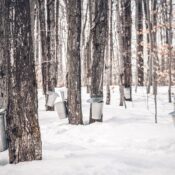In her 90-year-old, colonial-style Indianapolis home, Sara Snow easily rattles off how she religiously follows the tenets of green living. Dressed in pants made of wood pulp and an organic cotton shirt, this up-and-coming eco-friendly expert is among the true tree-huggers, “greenies” —her words—who do everything they can to live lightly.
All the food she and Ryan, her husband, buy is organic or natural, including the herbal tea she’s sipping. She uses cloth bags for purchases. Their German shepherd, Makana, eats natural dog food. Their bath towels, bed sheets, and bathrobes are made from organic cotton. She points out pieces of second-hand furniture —a small table, decorative tubs made of recycled tires. The natural living advocate advises shopping at local farmers’ markets for fresh produce or joining a community supported agriculture (CSA) group for a regular share of local, healthy crops.
They use natural cleansers—such as baking soda and vinegar—non-toxic shampoo and soap, and energy-efficient light bulbs. Behind the garage are two compost bins for tea bags, banana peels, and the like. Around front are curb-side recycling bins they regularly fill up. Her “green” list could go on, but the picture is clear.
This outgoing 32-year-old TV series creator and host on Discovery Networks, columnist, and new book author embodies the essence of what it means to live naturally, in tune with nature and the environment.
Her life is focused on spreading the “green living” gospel, ingrained in her as a child, to help other people make simple life changes she hopes will contribute to a sea change in their own health and the well-being of the environment.
“My mission is not to become some massive superstar and to have this whole empire built around me,” she said. “My mission is being on the ground and helping people find ways to live more naturally, so they can have healthier bodies, healthier children, and healthier homes. It’s so immensely important.”
Snow’s new book outlines a room-by-room guide to a more environmentally friendly home. Yet what we all need to do, she says, isn’t remarkably new. And it doesn’t have to be all that hard.
“We’re not inventing a new way of doing things. We’re really going back to the way we used to do things less than a 100 years ago. That’s why sometimes I call it simple living.
“We didn’t used to spray our crops with so many chemicals; we didn’t used to abuse our resources the way we do now; we didn’t used to view everything as being so disposable as it is now,” says Snow. Her first book, Sara Snow’s Fresh Living: The Essential Room-by-Room Guide to a Greener, Healthier Family and Home, comes out in March. Snow wants people to know that green living doesn’t have to be all or nothing. That’s a mistake a lot of people make, she says. They can take small steps, get comfortable with them, and move on to others. Living greener can be as simple as starting to cook at home more often, rather than going out so much, because you’ll likely eat healthier, she says, also adding to remember how your grandmother or mother made dishes, the food they cooked. Do some of those things. Buy locally grown foods and grow some of your own. Also, be intentional about not overbuying in general. Buying secondhand goods also helps cut down on needless waste, Snow says.
To make the biggest impact, Snow advises taking steps in three areas: eating less processed food and more organic food; cutting back on your home energy usage; and improving your transportation methods so you’re using less energy.
Organic products are still between 10 percent and 20 percent more expensive than nonorganic food, although in-season, local organic produce may not be any more expensive. If you can’t afford to buy all organic, Snow suggests at least buying organic milk (easy to find) and buying meat that’s hormone- and antibiotic-free.
Sara Snow’s Green Living Tips for the Home
In the kitchen
- Shop often to avoid overbuying of processed foods and to keep a steady amount of fresh foods on hand.
- Buy organic to avoid pesticide exposure and increase your antioxidant intake.
In the bathroom
- Buy recycled-content paper products like tissues and toilet paper.
- Take shorter showers and save up to five gallons of water per minute.
In the bedroom
- Try organic cotton sheets for a comfy and healthy, natural bed.
- Look for eco-friendly materials like organic wool and sustainable bamboo.
In the nursery
- Simplify and avoid overbuying for a clutter-free and environmentally sound nursery.
- Seek out natural body products for your baby’s sensitive skin.
In the living room
- Place energy-efficient CFLs (compact fluorescent light bulbs) in your most commonly used fixtures.
- Make use of secondhand furniture for a more eco-friendly choice.
In the laundry
- Avoid cleaning products with synthetic fragrances.
- Line dry your clothes, either inside or outside, for an energy-efficient laundry room.
In the office
- Avoid getting excess mail by asking catalog companies to take you off their lists.
- Unplug electronics like computers, printers, and televisions when not in use so they don’t waste power.
Throughout the home
- Use common plants to clear the indoor air, which is often more polluted than the air outside. Plants like gerbera daisy, English ivy, and bamboo palm are effective at helping to clean the air.
Outdoors
- Try composting as a way of recycling kitchen scraps into free fertilizer for your home gardens.
- Get a tune-up on your car to get the best gas mileage possible, no matter what kind of vehicle you drive.
- Install a rain barrel on a downspout of your home and make use of what comes down naturally to water your plants and gardens. The barrel can be store-bought or simply a recycled old barrel with a spigot installed toward the bottom.
- Become a member of a community supported agriculture (CSA) group for a weekly share of a local farm’s fresh and healthy crops. If you don’t have CSAs in your area, shop at a local farmers’ market for the best seasonal, fresh, and local foods.
Even though her life was quite different from her public school classmates’, she never felt deprived, nor did she envy the more typical foods they ate while she drank soy milk and munched on carob bars. Her parents taught her food can be used as medicine to make your body well, or it can do some serious harm.
“We felt like we were really a part of something big. At least there was a purpose behind it all, and my dad was helping to save the world through food,” recalls Snow, chuckling fondly. The knowledge she gained while growing up shaped her career. Snow is a graduate of Butler University in Indianapolis in telecommunications and theater performance. She worked as a television producer for ESPN’s SportsCentury series and then as a morning news reporter/ anchor for the Indianapolis Fox affiliate. But the lifestyle didn’t suit her, so after seven years she left to blend her life’s work with her life’s passion—green living.
In 2005 and 2007, Snow created and hosted two eco-lifestyle series, now shown in reruns on Discovery Health and FitTV. They’re called Living Fresh and Get Fresh With Sara Snow. Segments profile how companies and real people are living greener lifestyles. She also has regular segments on CNN.com LIVE; has her own Web site, sarasnow.com; is developing another TV series; and hopes to write another book. With all the attention on green living in the country, what’s holding people back? “Sometimes I think the hardest thing is just the first change, breaking the mold and changing your habits,” says Snow, an advisory board member for Discovery’s Planet Green, the first-ever, 24-hour green television network. “Once you’ve made that one change, the rest are much easier.” Snow is optimistic about the future of the green movement 10 or more years down the road. “At the very least, we will have slowed the rate at which we are destroying this very fragile planet.”
Snow is impressed by the environmental awareness of college-age Americans and even more by younger children. She believes that by the time they are running companies and households, if we aren’t already seeing serious changes, we will by then.
“My hope beyond that is we will start to live less as little selfish individuals in our own little bubbles,” she says. “We don’t interact with our neighbors; we don’t spend time outside interacting with the natural world.”
As for herself, Snow would like to recreate that idyllic time when her family members relied on each other, supported each other, and lived close together.
“My personal hope is that I’ll be back on a little family community, and all of my family will be living in a plot of land together. It’s such a perfect way to live.” From Sara’s Kitchen:
Lentil Soup
Makes 10 servings
“There is nothing better on a cold day than a warm kitchen. And there is nothing better when I’m feeling stressed, tired, or overworked, than a bowl of this lentil soup.”
- 1 quart chicken stock
- 1 quart water
- 2 cups red lentils, rinsed
- 1-2 tablespoons olive oil
- 2-4 strips of kombu* (optional)
- 2 onions
- 3 cloves garlic
- 5 carrots
- 4 stalks celery
- 1/2 pound potatoes
- 2 zucchini
- 1 can (28 ounces) diced tomatoes
- 3 teaspoons salt (optional)
- Pinch of each of the following: cumin, bay leaf, dried or fresh parsley, oregano, thyme.
- Bring first five ingredients to boil and allow to cook for 45-60 minutes.
- Chop together onions, garlic cloves, carrots, celery, potatoes, and zucchini.
- Add vegetables into pot.
- Add 1 can diced tomatoes.
- Add salt, cumin, bay leaf, parsley, oregano, and thyme to taste.
- Allow to simmer 10 minutes more.
- Serve piping hot with warm whole-grain bread.
*Kambu, a sea vegetable, can be found at most natural food stores or in Asian groceries.
Become a Saturday Evening Post member and enjoy unlimited access. Subscribe now




Comments
Yawn. I had hoped that the Saturday Evening Post would be different from today’s typical lifestyle/consumer magazines. This article is just one example that proves how far it has fallen. Chasing trends that are about 20 years old and beyond banal — like “going green” — is hardly a way to distinguish yourself. Why not really stand out and flout the trendy rather than embrace it?
I love your magazine! I have been a customer for years. I hope you can find me one of your soup recipes. The fall of 2007 where you feature the sweet potatoes and pumpkins, I saw a vegetable soup that had chunks of cut up sweet
potatoes. I made the soup and just loved the taste. I told others about the combination of all the right veggies and the sweet potatoes together that gave the soup a really distinct flavor. I cannot find my recipe, so here’s hoping you will
be able to send me the recipe that was featured in the fall edition of 2006 or 2007. Thanks so much